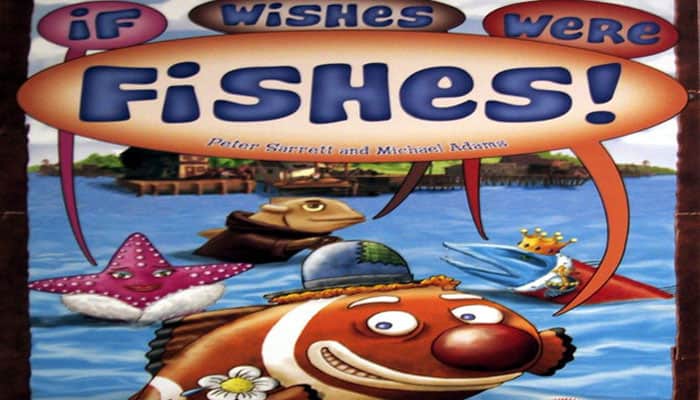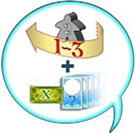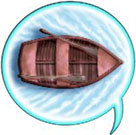
Components

- game board
- 70 fish cards
- 4 market full cards
- 75 wooden fish
- 30 worms
- 5 buyers
- Instructions
Setup
Each player takes all the fish of one color and six worms; place the remainder back in the box. Each player places one of his fish on the zero space of the scoring track [1]
Place the five buyers randomly among the markets, with no more than one buyer at any market[2].
Shuffle the fish cards and deal four cards face up in a single row (the "ocean"). Place the remainder of the deck face down next to the last card dealt [3].
Stack the market full cards in limit (number on the left) order: the 4 on top and the 7 on the bottom [4].
The players choose a starting player.

Game Play
Play proceeds in clockwise order. On his turn, a player must perform one of the following three options:
- Take a fish card from the ocean and put it in one of his boats.
- Take a fish card from the ocean, use the wish, and throw the fish card back onto the discard pile.
- Sell a single fish from one of his boats.
Taking a Fish Card From the Ocean
The card farthest from the deck is in the shallowest water; the card closest to the deck is in the deepest.
Whenever a player takes a fish from the ocean, he must first put a worm on any fish in shallower waters than the fish he's taking. To take the fish in the third place, for example, a player would have to put a worm onto each of the other two shallower face-up cards.

A player cannot take a face-down card from the deck.
The new card is always added in the deepest water. The remaining cards are pushed into the shallowest water possible and then the new card is added in the space next to the deck.
When a player takes a fish, he also takes all worms that have been dropped on that fish. He keeps these worms even if he throws the fish back.
Putting a Fish Card in a Boat
Each player begins the game with two imaginary boats, which are in his play area along with his supply of worms.
When a player keeps a fish, he adds the card to an empty boat. No boat can ever hold more than one card. If all of a player's boats are full he may not put another fish in a boat.

Throwing a Fish Card Back
Instead of keeping a fish, a player can throw it back into the ocean (discard pile). As a reward for doing so, the fish grants the player the wish shown at the top of the card. The effect of this wish is carried out immediately.

Selling a Single Fish
If a player does not want to take any fish from the ocean, he may instead sell a single fish from one of his boats. This is the player's entire turn.
If the card being sold is a double fish, it is sold as just one fish. Double fish cards only become double fish when sold via a wish.
Selling Fish
Players earn money by selling fish to markets and having a majority of fish in a market when it fills up. Each market only buys one kind of fish, as shown on that market space. Normally, a market pays two dollars per fish sold.
If there are buyers at the market, the price paid for each fish is increased by the value of the buyer. A market with a "1" and a "3" buyer, for example, would pay six dollars per fish.
A player scores his sale by advancing his marker along the scoring track. He then places the sold fish card on the discard stack.
For each fish sold, the player adds a fish of his color to the corresponding market. If a player oversells to a market (see below), he places any extra fish on the garbage heap (behind the fence on one side of the board) instead of the market.
The player is paid for all fish sold, including those placed on the garbage heap.

Filling Markets
Each market can only hold a certain number of fish before it becomes full. The maximum number of fish a market can hold is shown on the topmost market limit card in the stack.
A market becomes full as soon as it contains that number of fish, and may never contain more fish than its capacity. If a single sale to the market would bring that market over its capacity, any extra fish is placed on the garbage heap instead of the market.
When a market fills up, bonuses are awarded. The player with the most fish in the market earns the higher of the two values shown on the topmost market limit card.
The player with the second-most fish earns the lower of the two values. In the case of a tie for first, add both values together and award each tied player half (rounded down), and nobody scores for being second.
In a tie for second, all tied players score the full second-place points.
Once points have been awarded, place the topmost "market limit" card on top of the just-filled market. Any fish sold to a full market are sold for full price, but are placed on the garbage heap.

Wishes
A player must perform all aspects of a wish, if possible. If a player cannot perform one part of a wish, he must still perform the other. Only fish in the current player's boats may be sold.
-

Move Buyer 1:
Move one 1-point buyer 1-3 markets clockwise, then sell all of one kind of fish.
-

Move Buyer 2:
Move one 2-point buyer 1-3 markets clockwise, then sell all of one kind of fish.
-

Move Buyer 3:
Move the 3-point buyer 1-3 markets clockwise, then sell a single fish card. If you sell a double fish card, you get double payment.
-

Spoilage:
Move any one fish from an open (unscored) market to the garbage heap, or from the garbage heap back to its owner's supply, then sell any one fish card, if possible.
-

Worm Bonus:
Score one dollar for every worm you hold, then give a worm to each other player. Any worms on that card count toward the bonus.
-

Boat:
Turn this card face-down and keep it in front of you for the rest of the game. This card represents an extra boat, allowing you to hold an extra fish card. There is no limit to how many boats a player may have.
-

Spread All Buyers:
From each market with more than one buyer, remove all buyers except the one with the highest value at that market. Place the removed buyers on any empty markets. When you are finished, no market may have more than one buyer.
-

Sell all of one kind off Fish:
Sell all cards of a single type. Seven type of fishes: Angelfish, Monkfish, Swordfish, Kingfish, Catfish, Starfish, Clownfish.
-

Sell all of one kind of fish as another kind:
Sell all of one kind of fish as if they were the other fish shown on the card.
This wish effectively changes these fish into the depicted fish type. They are sold to the corresponding market and the player is paid by the buyers (if any) at that market.
-

Double Fish
If this card is sold via a wish, it counts as 2 fish. If sold instead of drawing a card, it counts as 1 fish.
End of the Game
The game ends when either of two conditions is met:
All market limit cards are on markets OR
Ten or more fish are on the garbage heap. If this happens, the garbage heap is evaluated as described above for a full market, but the top two players lose the dollars shown on the topmost "market limit" card instead of gaining them.

Regardless of how the game ends, the player with the most worms scores an eight dollar bonus. The player with the second-most worms scores a four dollar bonus.
In the case of a tie for most worms, all tied players score six dollars and nobody scores for second place. In the case of a tie for second-most worms, all tied players score four dollars.
The player with the most dollars wins.
Continue Reading
